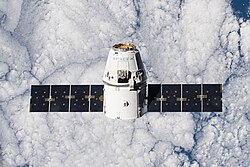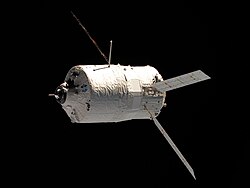Progress M-25M
| Progress M-25M (Прогресс М-25M) | |||
 | |||
| Tillverkare | RSC Energia | ||
|---|---|---|---|
| Modell | Progress-M 11F615A60 | ||
| Färdens tid | 179 dagar, 4 timmar | ||
| NSSDC-ID | 2014-067A[1] | ||
| Uppskjutning | |||
| Startplats | Bajkonur 31/6 | ||
| Raket | Sojuz-2.1a | ||
| Uppskjutning | 29 oktober 2014, 07:09:43 UTC | ||
| Återinträde | |||
| Återinträde | 26 april 2015, 12:57 UTC | ||
| Omloppsbana | |||
| Apogeum | 423 km | ||
| Perigeum | 418 km | ||
| Banlutning | 51,6° | ||
| Varv | 2 786 st[2] | ||
| Dockning | |||
| Rymdstation | ISS | ||
| Dockning | 29 oktober 2014, 13:08 UTC | ||
| Dockningsport | Pirs, nadir | ||
| Ur dockning | 25 april 2015, 06:41:14 UTC | ||
| Tid dockad | 177 dagar, 17 timmar, 33 minuter | ||
| Last upp | |||
| Upp | 2 351 kg | ||
| Kronologi | |||
| |||
Progress M-25M (ryska: Прогресс М-25M) eller som NASA kallar den, Progress 57 eller 57P, är en rysk obemannad rymdfarkost som levererade förnödenheter, syre, vatten och bränsle till rymdstationen ISS. Den sköts upp med en Sojuz-2.1a-raket från Kosmodromen i Bajkonur 29 oktober 2014 och dockade med ISS knappt 6 timmar senare.
Farkosten lämnade stationen den 25 april 2015 och brann upp i jordens atmosfär den 26 april 2015.
Källor
Fotnoter
- ^ ”NASA Space Science Data Coordinated Archive” (på engelska). NASA. https://nssdc.gsfc.nasa.gov/nmc/spacecraft/display.action?id=2014-067A. Läst 1 mars 2020.
- ^ Manned Astronautics - Figures & Facts Arkiverad 5 oktober 2015 hämtat från the Wayback Machine., läst 22 juli 2016.
| |||||||||||||||||||||||||
| ||||||||||||||||||||||||||||||||
| ||||||||||||||||
Media som används på denna webbplats
ISS Progress cargo spacecraft (NASA)
An unpiloted Progress 11 supply vehicle departs from the Pirs Docking Compartment on the International Space Station (ISS) at 2:42 p.m. (CDT) on September 4, 2003 for another month alone in orbit, as part of a Russian scientific experiment. It will then be deorbited with its load of trash and unneeded equipment and burn in the Earth's atmosphere.
A Progress supply ship linked up to the orbiting International Space Station (ISS) at 3:48 GMT, November 18, bringing Expedition 1 commander William M. Shepherd, pilot Yuri P.
Gidzenko and flight engineer Sergei K. Krikalev two tons of food, clothing, hardware and holiday gifts from their families. The photograph was taken with a 35mm camera and the film was later handed over to the STS-97 crew members
for return to Earth and subsequent processing.Backdropped by a cloud-covered part of Earth, the Orbital Sciences' Cygnus cargo craft approaches the International Space Station, photographed by an Expedition 40 crew member. The two spacecraft converged at 6:36 a.m. (EDT) on July 16, 2014.
ISS021-E-017623 (30 Oct. 2009) --- Backdropped by a cloud-covered part of Earth, the unpiloted Japanese H-II Transfer Vehicle (HTV), filled with trash and unneeded items, departs from the International Space Station. European Space Agency astronaut Frank De Winne, Expedition 21 commander; NASA astronaut Nicole Stott and Canadian Space Agency astronaut Robert Thirsk, both flight engineers, used the station's Canadarm2 robotic arm to grab the HTV cargo craft and unberth it from the Harmony node's nadir port. The HTV was successfully unberthed at 10:18 a.m. (CDT) on Oct. 30, 2009, and released from the station's Canadarm2 at 12:32 p.m.
This image, photographed by one of the Expedition 42 crew members aboard the International Space Station, shows the SpaceX Dragon cargo craft approaching on Jan. 12 2015 for its grapple and berthing and the start of a month attached to the complex. Dragon carried more than 2 ½ tons of supplies and experiments to the station.
ISS026-E-037172 (24 Feb. 2011) --- Surrounded by the blackness of space, the European Space Agency's "Johannes Kepler" Automated Transfer Vehicle-2 (ATV-2) approaches the International Space Station. Docking of the two spacecraft occurred at 10:59 a.m. (EST) on Feb. 24, 2011.
Traveling about 261 miles over the Atlantic Ocean, the unpiloted ISS Progress 57 Russian cargo ship docked at 9:08 a.m. EDT to the Pirs Docking Compartment of the International Space Station.
The craft is delivering almost three tons of food, fuel and supplies, including 1,940 pounds of propellant; 48 pounds of oxygen; 57 pounds of air; 926 pounds of water; and 2,822 pounds of spare parts, supplies and experiment hardware for the six members of the Expedition 41 crew currently living and working in space. Progress 57 is scheduled to remain docked to Pirs for the next six months.













